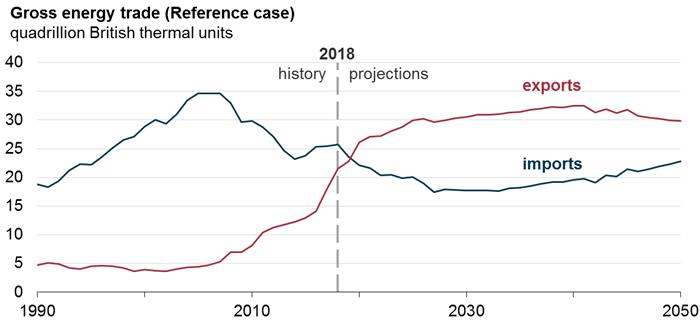
The Energy Edge: US Nears the Edge of Global Energy Dominance
Today’s Takeaway: U.S. Nears the Edge of Global Energy Dominance
After becoming a net oil exporter for the first time since the 1940s back in November 2018, the U.S. is showing no signs of losing the title of Global Energy Leader any time soon.
In late January, the U.S. Energy Information Administration (EIA) released its Annual Energy Outlook 2019 (AEO2019), projecting significant continued development of U.S. shale and tight oil and natural gas resources, as well as continued growth in use of renewable resources. As part of the report, EIA projects that in 2020, the country will export more overall energy sources than it imports and will remain a net energy exporter through at least 2050. This projection is driven mostly by the boom in natural gas and crude oil production, along with a growing renewable market.

Source: U.S. Energy Information Administration, Gross Energy Trade
What’s the point?
Everything from the production of crude oil and natural gas to wind and solar generation is thriving here at home.
In its report, EIA highlighted the impact of sustained low natural gas prices and declining costs of renewables as key reasons for long-term optimism in the U.S. energy space. Natural gas is expected to maintain its leading share of electricity generation and, with ample supply and assumed pipeline construction, it will continue to grow, increasing from 34 percent of the electricity generation fuel mix in 2018 to 39 percent in 2050. In the crude oil space, 2018 saw the U.S. produce almost 11 million barrels of crude oil per day, breaking its previous crude oil production record of 9.6 million barrels per day set way back in 1970.
The renewables share, driven mostly by wind and solar generation, is also predicted to increase from 18 percent of the mix in 2018 to 31 percent in 2050. Interestingly, the AEO2019 reference case projects that renewables will surpass nuclear and coal as a share of U.S. electric generation in less than 10 years.
Why should I care?
There’s no way to say it too lightly – the U.S. is on the edge of attaining what was for decades considered completely unattainable as it relates to energy. Oil, natural gas and renewable production are each at or approaching all-time highs with no slow down expected in the immediate or distant future. Importantly, improving energy efficiency across all end-use sectors should keep consumption of domestic energy relatively stable despite a growing U.S. economy. The AEO2019 reference case predicts that U.S. energy consumption will grow across all major end-use sectors, with consumption of electricity and natural gas growing the fastest.
However, ensuring that this growth continues will require local and federal governments to be smart about how any regulation they consider could impact the larger economy and long-term employment prospects in this crucial industry. Keeping an open dialogue with lawmakers is a must to keep this momentum going. And with the share of natural gas and renewable energies expanding, the U.S. is not only improving its worldwide energy standing, but its electric power generation mix is getting cleaner – something that the industry could certainly be touting more.
While the U.S. energy sector can’t exactly put its feet up yet and simply cruise to continued success, it is safe to expect that the U.S. will continue to be a significant net energy exporter for a very long time.
For more cutting-edge perspectives on the most compelling news, facts and figures impacting the U.S. energy industry, read other editions of The Energy Edge.


